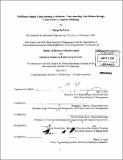| dc.contributor.advisor | Stephen C. Graves and David Simchi-Levi. | en_US |
| dc.contributor.author | De Naray, Margo (Margo Taylor) | en_US |
| dc.contributor.other | Leaders for Global Operations Program. | en_US |
| dc.date.accessioned | 2010-10-12T17:45:09Z | |
| dc.date.available | 2010-10-12T17:45:09Z | |
| dc.date.issued | 2010 | en_US |
| dc.identifier.uri | http://hdl.handle.net/1721.1/59155 | |
| dc.description | Thesis (M.B.A.)--Massachusetts Institute of Technology, Sloan School of Management; and, (S.M.)--Massachusetts Institute of Technology, Engineering Systems Division; in conjunction with the Leaders for Global Operations Program at MIT, 2010. | en_US |
| dc.description | "June 2010." Cataloged from PDF version of thesis. | en_US |
| dc.description | Includes bibliographical references (p. 58). | en_US |
| dc.description.abstract | The fulfillment supply chain consists of all activities associated with packing, storing, and transporting a product from the manufacturer to the customer. In the global environment, it is a challenge to accurately measure the impact of a given strategy on logistics costs quickly and efficiently. While much focus has been given to supply chain strategy as a whole, less has been applied to specific implications of packaging fulfillment decisions. The goal of this research is to analyze the cost impact on the global fulfillment supply chain for given packaging strategies. Through the development of a comprehensive logistics model, I attempt to identify cost drivers and sensitivities in the networks and recommend strategies to mitigate adverse impacts. Specifically, this research pertains to the fulfillment of notebook computers and associated accessories at Dell, Inc.; however, the insights can be generalized to any consumer product firm with a variety of products, serving customers in multiple regions of the world. The model development and implementation results indicate that the lowest cost strategy for Dell's current fulfillment supply chain consists of minimizing the system box contents at the factory and fulfilling additional accessories separately in the customer region. Inbound costs are the most significant factor in the total fulfillment logistics cost. Every effort should be made to reduce this cost by minimizing the weight of the system box shipped from the manufacturer. Additionally, it is evident that regional logistics costs in the three major customer markets for Dell: Americas, Europe-Middle East- Africa, and Asia-Pacific-Japan, are not uniformly affected by differences in packaging strategies. These differences are the result of specific cost bases and product demand profiles associated with the regions. Therefore, I recommend evaluating future fulfillment strategies with this model to understand the specific cost impact on individual regions on an ongoing basis. | en_US |
| dc.description.statementofresponsibility | by Margo de Naray | en_US |
| dc.format.extent | 58 p. | en_US |
| dc.language.iso | eng | en_US |
| dc.publisher | Massachusetts Institute of Technology | en_US |
| dc.rights | M.I.T. theses are protected by
copyright. They may be viewed from this source for any purpose, but
reproduction or distribution in any format is prohibited without written
permission. See provided URL for inquiries about permission. | en_US |
| dc.rights.uri | http://dspace.mit.edu/handle/1721.1/7582 | en_US |
| dc.subject | Sloan School of Management. | en_US |
| dc.subject | Engineering Systems Division. | en_US |
| dc.subject | Leaders for Global Operations Program. | en_US |
| dc.title | Fulfillment supply chain strategy evaluation : understanding cost drivers through comprehensive logistics modeling | en_US |
| dc.type | Thesis | en_US |
| dc.description.degree | S.M. | en_US |
| dc.description.degree | M.B.A. | en_US |
| dc.contributor.department | Leaders for Global Operations Program at MIT | en_US |
| dc.contributor.department | Massachusetts Institute of Technology. Engineering Systems Division | |
| dc.contributor.department | Sloan School of Management | |
| dc.identifier.oclc | 659549744 | en_US |
